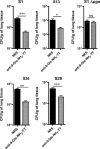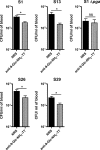Poly-N-acetyl-β-(1-6)-glucosamine is a target for protective immunity against Acinetobacter baumannii infections
- PMID: 22104104
- PMCID: PMC3264292
- DOI: 10.1128/IAI.05653-11
Poly-N-acetyl-β-(1-6)-glucosamine is a target for protective immunity against Acinetobacter baumannii infections
Abstract
Acinetobacter baumannii has emerged as a highly troublesome, global pathogen. Treatment is complicated by high levels of antibiotic resistance, necessitating alternative means to prevent or treat A. baumannii infections. We evaluated an immunotherapeutic approach against A. baumannii, focusing on the surface polysaccharide poly-N-acetyl-β-(1-6)-glucosamine (PNAG). We used a synthetic oligosaccharide of 9 monosaccharide units (9Glc-NH(2)) conjugated to tetanus toxoid (TT) to induce antibodies in rabbits. In the presence of complement and polymorphonuclear cells, antisera to 9Glc-NH(2)-TT mediated the killing of A. baumannii S1, a high-PNAG-producing strain, but not its isogenic PNAG-negative, in-frame deletion mutant strain, S1 Δpga. Complementing the pgaABCD locus in trans in the shuttle vector pBAD18kan-ori, plasmid Δpga-c, restored the high levels of killing mediated by antibody to PNAG observed with the wild-type S1 strain. No killing was observed when normal rabbit serum (NRS) or heat-inactivated complement was used. Antiserum to 9Glc-NH(2)-TT was highly opsonic against an additional four unrelated multidrug-resistant clinical isolates of A. baumannii that synthesize various levels of surface PNAG. Using two clinically relevant models of A. baumannii infection in mice, pneumonia and bacteremia, antisera to 9Glc-NH(2)-TT significantly reduced levels of A. baumannii in the lungs or blood 2 and 24 h postinfection, respectively, compared to levels of control groups receiving NRS. This was true for all four A. baumannii strains tested. Overall, these results highlight the potential of PNAG as a vaccine component for active immunization or as a target for passive antibody immunotherapy.
Figures




References
-
- Aarabi B. 1987. Comparative study of bacteriological contamination between primary and secondary exploration of missile head wounds. Neurosurgery 20:610–616 - PubMed
-
- Abbo A, Carmeli Y, Navon-Venezia S, Siegman-Igra Y, Schwaber MJ. 2007. Impact of multi-drug-resistant Acinetobacter baumannii on clinical outcomes. Eur. J. Clin. Microbiol. Infect. Dis. 26:793–800 - PubMed
-
- Al-Sweih NA, Al-Hubail MA, Rotimi VO. 2011. Emergence of tigecycline and colistin resistance in Acinetobacter species isolated from patients in Kuwait hospitals. J. Chemother. 23:13–16 - PubMed
Publication types
MeSH terms
Substances
Grants and funding
LinkOut - more resources
Full Text Sources
Other Literature Sources

